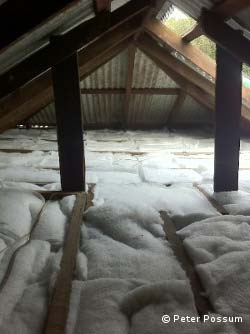Ceiling insulation reduces the cost of keeping your house warm in winter and cool in summer, which is becoming more important as the cost of electricity rises.
There are 4 main types:
- Reflective insulation: thick or thin foil sheets that mainly reflect radiant heat (explained below)
- Bulky insulation: made from glass fiber, polystyrene, polyester or wool. Typically sold as insulation batts, it reduces convection and conducted heat (explained below)
- Loose Insulation: usually made of cellulose (paper), treated with a fire retardant that is blown into cavities e.g. Cool& Cosy; it works in the same way as bulky insulation and may be the only way to insulate narrow cavities, without lifting the roof sheeting. Some types release fine particles that can fall into the house through light fittings and ceiling vents. This can also be a problem with glass fiber batts when they are older and start to deteriorate.
- Combination insulation: a reflective surface of foil is attached to insulation batts or other more rigid insulation material
Types of Heat Transfer:
- Radiant heat: travels in waves through the air and includes the heat energy of the sun
- Convection heat: travels with an air current like a warm wind
- Conducted Heat: transfers through a material for example from touching the hot underside of a metal roof

In a typical roof all three types of heating or cooling will occur. If an iron roof is not insulated then the sun’s radiant heat will conduct through the metal and heat the air inside the roof, which moves and transfers the heat by convection to the top side of the ceiling from where it will be conducted through to the room below. Insulation batts and ceiling insulation substantially reduce the heat that can flow through the ceiling.
R Values
The effectiveness of the different ceiling insulation materials is compared by measuring the ability of a given material to prevent the transfer of heat. That measurement is called an R Value. A higher value means the material is more effective in reducing the heat flow into your house.
Sometimes “up” and “down” R-values are quoted, referring to the resistance of the insulation to heat flow upwards (sometimes called a Winter R value) or to the effectiveness in resisting downwards heat flow (called a Summer R value).
In Brisbane for protection from summer heat a high “down” or Summer R value is preferred but for good quality insulation material, there is little difference between up and down and this is a refinement mainly used by ceiling insulation sales staff.
For ceiling insulation in Brisbane, we recommend an R-value of 3 (or more) and a minimum of 1.5.
What Insulation Does Peter the Possum Man Recommend?
For Brisbane ceiling insulation, we recommend polyester R3 batts because:
- They are long lasting (do not disintegrate)
- They have an excellent insulation value
- No risk of allergies
- Safe for insulation installers and others working in the roof space
We can also remove old roof insulation and do a ceiling clean with a roof vacuum before new insulation is installed.
Call or email Peter the Possum & Bird Man with any questions or ask for a free* quote to arrange for installation of quality ceiling batts in Brisbane today.







